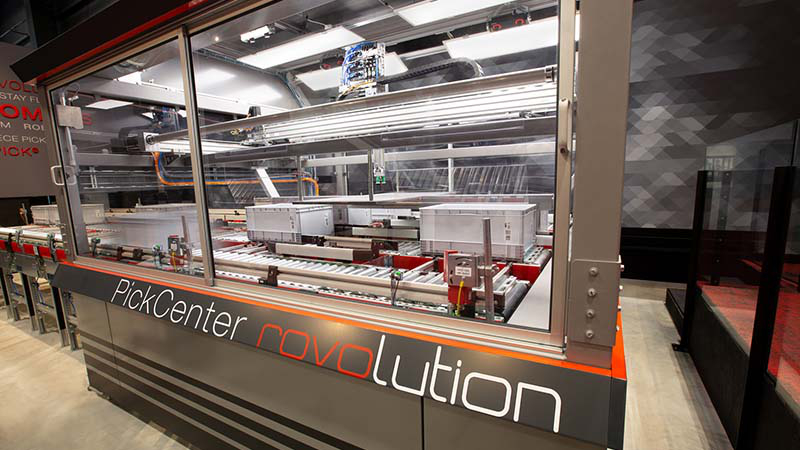- Predictive maintenance in focus
- For ‘Rovolution’, the award winning robotic picking technology, TGW relies on condition monitoring
- Digital Twin as a central innovation in the age of Industry 4.0
(Marchtrenk, 19th April 2021) In the course of Industry 4.0, down-times of systems can be significantly reduced by implementing condition monitoring applications. ‘The goal is to optimize system availability continuously’, says Dr Maximilian Beinhofer, Head of Cognitive Systems Development at the warehouse automation specialist TGW.
What are the disadvantages of models, which focus on doing maintenance tasks, only when a component stops working?
Maximilian Beinhofer: This approach is known as ‘corrective maintenance’. It can entail a machine or system coming to a standstill. Availability is reduced, which can cause economic disadvantages for the user. Additionally in some causes it can happen, that you need to do time-consuming research first in order to identify, what caused the errors.
As an alternative, you can simply replace wear parts at regular intervals…
Yes, this is called ‘preventive maintenance’. The idea is to pro-actively define specific maintenance or replacement cycles based on empirically established data. This approach guarantees very high system availability. The drawback is that costs are higher because some parts are getting replaced before their lifetime has expired. The crux of the matter is to find the ideal moment – both for the supplier and for the user. In this regard, condition monitoring as well as the approach of predictive maintenance provides a good solution. Predictive maintenance uses digital twins as basis and is considered one of the central innovations in the area of Industry 4.0.
How does predictive maintenance work?
Based on condition monitoring and by implementing sensors, you can use software simulation to identify and forecast problems at a very early stage. This is ideally done in real time or with only minimal delay. The idea behind our approach is: We use smart algorithms – from the fields of machine learning and data science – to link and merge available data from sensors, which allow us to make very precise statements about the condition or wear of components. This approach reduces costs because we don't have to install additional sensors.
Can you name an actual example?
In our award-winning robotic picking technology ‘Rovolution’, we measure the status of the vacuum in the gripping device. If there is a pressure loss, for example due to the dust load in the environment, an alert informs the user immediately, who can quickly react.

What would you recommend in regards of older systems that are not equipped with the necessary sensors?
There is the option of installing additional sensors – to measure vibrations, for instance. Depending on the size of the system, the number of sensors required may range between just a few and several hundred. For this reason, a cost-benefit analysis must be done beforehand. But in general, retrofitting existing material handling systems is absolutely possible.
What is the difference between predictive and prescriptive maintenance?
The two approaches build upon each other. You need condition monitoring as a basis for predictive maintenance. It is not enough to know whether a sensor is occupied or not. The core behind it is to know the extent of the wear. If these data points are available, you can apply predictive maintenance software to make assumptions, for example if a component that has reached a specific value, can be used for instance approximately another three months. Prescriptive maintenance will then give advice on what exact steps need to be taken during the next three months.
What are the main benefits of predictive maintenance?
The point is, generally spoken, to optimize the system availability while keeping costs low. In addition, the feedback loop improves continuously. Algorithms ensure that the self-learning system will optimize itself continuously.
In which areas does predictive maintenance make sense?
Generally, anywhere within a system. However, the linking elements are the most important ones. For instance, if one out of ten picking workstations fails, ninety percent of the capacity is still available. But if a sorting system fails that all articles pass through, an immediate standstill is the consequence.
What are the challenges of predictive maintenance?
On the one hand, the goal is to create maximum leverage with minimum effort. On the other hand, it is a technological challenge to use the networks within the system in a way that the data required for the predictive maintenance software can be transmitted. The feedback loops are the third challenge. If problems occur for example within the conveyor system, the on-site technicians have to report them. As a manufacturer, you have to provide intelligent methods that allow this immediate feedback, but also to prepare it in a way that it can be evaluated automatically.
How do you guarantee this?
In order to be able to train algorithms, you need to know exactly when a maintenance task was performed and what exactly has been done. Otherwise the system will believe that an improvement has come about on its own without external input. It is important, that this report is not based on open text filled in by the technician. It must be standardized data based on – for example – drop-down menus, as it needs to be machine-readable in order to train the machine learning system. At the same time, the user interface needs to be intuitive, so that the feedback can be given easily and quickly by the maintenance technician.
For which modules does TGW develop predictive maintenance?
Condition monitoring is already available for TGW’s robotic picking technology ‘Rovolution’. At the same time, we are developing a specific cloud solution for data acquisition and processing. The idea is that all data – from mechatronics to IT – are being recorded. Of course, this process will comply with the GDPR and data security. We record the data of multiple customers. This comes with the advantage that a new customer will benefit from the data of existing customers and receives advice from the software on what to do in order to optimize their system.
The digital twin is the outcome of this process. You can either use the replay mode to analyze what has happened, or you can view in real time what is happening right now. An additional step allows you to look into the future and make predictions.

How will the demand for predictive maintenance solutions develop?
The topic is very popular at the moment. I assume that within five or ten years all systems sold, will have incorporated predictive maintenance applications. Already now, it is has become a standard that large individual modules are equipped with a vibration sensor. In material handling installations interlinked over a large geographical area, various strategies are currently in use.
Do customers see the benefit, and are they willing to pay for such services?
I believe that in the long term, the business models behind maintenance contracts will change. The new tools and services offer many advantages for customers – and these advantages will ultimately be visible in the Total Cost of Ownership (TCO). Accordingly, we will also adapt our business models.
Thank you very much for the conversation, Maximilian!



